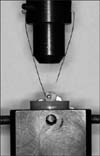1. Bishara SE, Ajlouni R, Soliman MM, Oonsombat C, Laffoon JF, Warren J. Evaluation of a new nano-filled restorative material for bonding orthodontic brackets. World J Orthod. 2007. 8:8–12.
2. Almy D. Bonding properties of newly erupted and mature human premolars. 2004. Virginia Commonwealth University;Master of Science Thesis.
3. Crabb HS. The porous outer enamel of unerupted human premolars. Caries Res. 1976. 10:1–7.

4. Bonar LC, Shimizu M, Roberts JE, Griffin RG, Glimcher MJ. Structural and composition studies on the mineral of newly formed dental enamel: a chemical, x-ray diffraction, and 31P and proton nuclear magnetic resonance study. J Bone Miner Res. 1991. 11:1167–1176.

5. Ooya K. A scanning electron microscopic study on the differences between newly erupted teeth and old teeth with reference to fissure enamel surfaces and contents. Bull Tokyo Med Dent Univ. 1977. 24:89–102.
6. Brudevold F, Aasenden R, Bakhos Y. A preliminary study of posteruptive maturation of teeth in situ. Caries Res. 1982. 16:243–248.

7. Sfondrini MF, Cacciafesta V, Pistorio A, Sfondrini G. Effects of conventional and high-intensity light-curing on enamel shear bond strength of composite resin and resin-modified glass-ionomer. Am J Orthod Dentofacial Orthop. 2001. 119:30–35.

8. Romano FL, Tavares SW, Nouer DF, Consani S, Borges de Araujo Magnani MB. Shear bond strength of metallic orthodontic brackets bonded to enamel prepared with Self-Etching Primer. Angle Orthod. 2005. 75:849–853.
9. White LW. An expedited indirect bonding technique. J Clin Orthod. 2001. 35:36–41.
10. Kotsanos N, Darling AI. Influence of posteruptive age of enamel on its susceptibility to artificial caries. Caries Res. 1991. 25:241–250.

11. Tüfekçi E, Almy DM, Carter JM, Moon PC, Lindauer SJ. Bonding properties of newly erupted and mature premolars. Am J Orthod Dentofacial Orthop. 2007. 131:753–758.

12. Jacobs G, Kuftinec MM, Showfety KJ, von Fraunhofer JA. Bonding characteristics of impacted versus erupted permanent teeth. Am J Orthod. 1986. 89:242–245.

13. Oliver RG. Bond strength of orthodontic attachments to enamel from unerupted and erupted young permanent teeth. Eur J Orthod. 1986. 8:123–126.

14. Artun J, Bergland S. Clinical trials with crystal growth conditioning as an alternative to acid-etch enamel pretreatment. Am J Orthod. 1984. 85:333–340.

15. Sheen DH, Wang WN, Tarng TH. Bond strength of younger and older permanent teeth with various etching times. Angle Orthod. 1993. 63:225–230.
16. Bhaskar SN. Orban's oral histology and embryology. 1980. 9th ed. St. Louis, Toronto, London: The C.V. Mosby;46–106.
17. Nordenvall KJ, Brannstrom M, Malmgren O. Etching of deciduous teeth and young and old permanent teeth: a comparison between 15 and 60 seconds of etching. Am J Orthod Dentofacial Orthop. 1980. 78:99–108.
18. Sharma-Sayal SK, Rossouw PE, Kulkarni GV, Titley KC. The influence of orthodontic bracket base design on shear bond strength. Am J Orthod Dentofacial Orthop. 2003. 124:74–82.

19. MacColl GA, Rossouw PE, Titley KC, Yamin C. The relationship between bond strength and orthodontic bracket base surface area with conventional and microetched foil-mesh bases. Am J Orthod Dentofacial Orthop. 1998. 113:276–281.

20. Buyukyilmaz T, Usumez S, Karaman AI. Effect of self-etching primers on bond strength - are they reliable? Angle Orthod. 2003. 73:64–70.
21. Dorminey JC, Dunn WJ, Taloumis LJ. Shear bond strength of orthodontic brackets bonded with a modified 1-step etchant and primer technique. Am J Orthod Dentofacial Orthop. 2003. 124:410–413.

22. Bishara SE, VonWald L, Laffoon JF, Warren JJ. Effect of a self-etch primer/adhesive on the shear bond strength of orthodontic brackets. Am J Orthod Dentofacial Orthop. 2001. 119:621–624.

23. Larmour CJ, Stirrups DR. An ex vivo assessment of a bonding technique using a self-etching primer. J Orthod. 2003. 30:225–228.
24. Davari AR, Yassaei S, Daneshkazemi AR, Yosefi MH. Effect of different types of enamel conditioners on the bond strength of orthodontic brackets. J Contemp Dent Pract. 20071. 8:36–43.

25. Tay FR, Sano H, Carvalho R, Pashley EL, Pashley DH. An ultra-structural study of the influence of acidity of self-etching primers and smear layer thickness on bonding to intact dentin. J Adhes Dent. 2000. 2:83–98.
26. Miller MB. Self-etching adhesives: solving the sensitivity conundrum. Pract Proced Aesthet Dent. 2002. 14:406.




 PDF
PDF ePub
ePub Citation
Citation Print
Print










 XML Download
XML Download